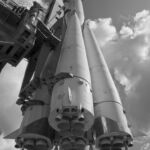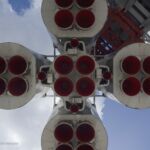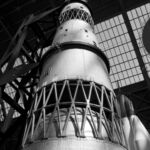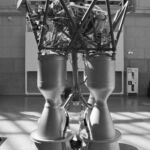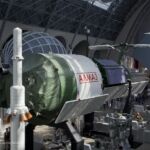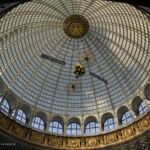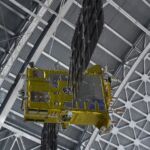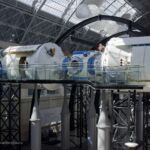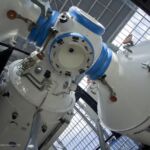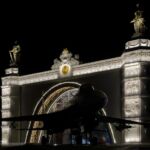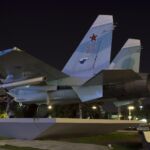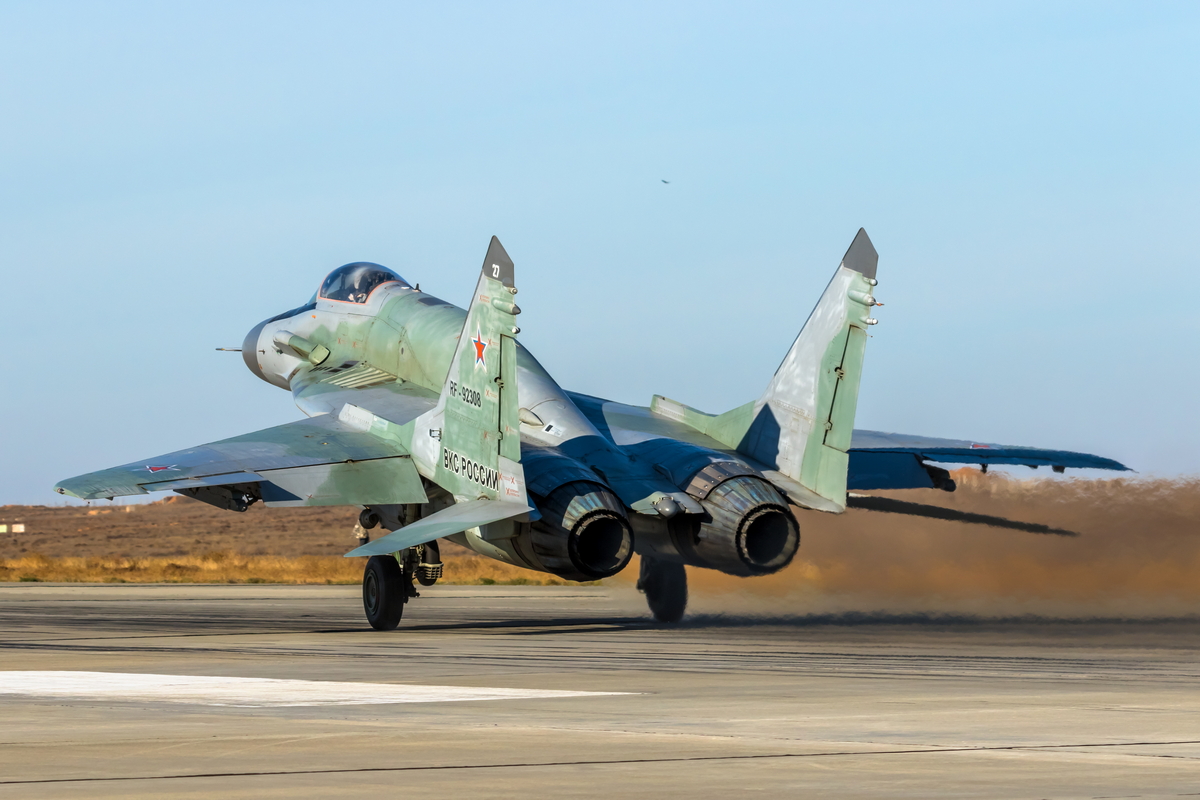
Only a short walk away from the famous ´Conquerors of Space´ memorial in Moscow, there is an interesting museum focused in the space exploration history, located within an area of the VDNH trade show and amusement park. This museum is relatively new, as opened in 2018, and not exactly popular among the foreign visitors, nevertheless it offers a fantastic experience of learning about the outer space, its research and, above all, the Soviet and Russian space programmes.
The Exhibition of Achievements of National Economy (Выставка достижений народного хозяйства), usually abbreviated as ´VDNH´, ´VDNKh´ or ´VDNHa´ (Russian: ВДНХ), was established in the late 1930s, being initially the All-Union Agricultural Exhibition. After the World War II, the site was renovated and the exhibition purpose was altered for presenting the achievements of the Soviet economy and industry. During the years, the area changed its purpose and style several times, finally evolving – after an enormous reconstruction and revitalisation of the area done in late 2010s – into the general purpose trade show area and amusement park with several interesting museums located there. Today, the VDNH covers an area of more than 240 hectares and is one of the most popular recreational locations in Moscow.
The aviation and space exhibition at the VDNH is located at the end of the central alley, approximately 1,500 metres from the main entrance. Already from afar one can spot the biggest single exhibit at the VDNH and, at the same time, one of the major attractions of the space exhibition – a ´Vostok´ 8K72K rocket with the launching ramp.
The ´Vostok´ rockets family was used in the early years of the Soviet space programme, including the first manned spaceflight of Yuri Gagarin in ´Vostok 1´. And exactly the rocket exhibited in front of the ´Space pavilion´ is showing us how the first crewed spacecraft looked like. Moreover, it is not a full-scale replica but a real backup rocket from 1961, being then ready to replace the Gagarin´s rocket in case of any technical problems.
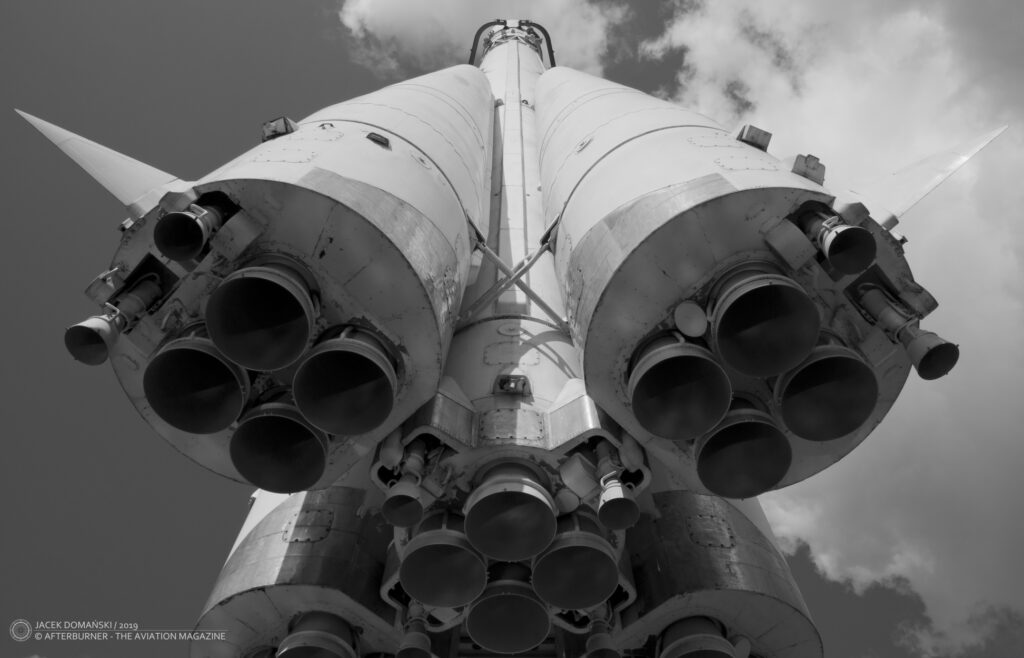
Looking around the square dominated by the ´Vostok´ rocket, one can locate three other aviation exhibits: Yak-42 regional airliner, Mi-8T multi-purpose helicopter and Su-27 fighter jet. There was also a Tu-154 displayed there, but in 2008 it was dismantled and regrettably scrapped.
The 32nd pavilion of the VDNH was built between 1938-1939, initially being designed for an exhibition named ´Mechanization and electrification of agriculture in the USSR´ (Механизация и электрификация сельского хозяйства СССР). During the following years, the exhibition – and pavilion itself – changed its name several times, being then ´Machine Engineering´ (in the 1950s and the 1960s), ´Urban Planning´ (1961) and finally ´Space and Machine Engineering´ since 1967.
The initial exposition displayed in the 32nd pavilion was focused on the Soviet Union´s successful development in the area of mechanization and electrification. It was divided in some sectors, such as tractor and automotive industry, agricultural engineering, new methods of drainage, new technologies of grain cropping. With the change of its name to ´Machine Engineering´, the exposition was then focused on products and technologies of the Soviet industry – from metallurgy to precision measuring instruments.
The original pavilion from 1930s was created by architects V. Andreev, I. Taranov and N. Bykova. It was designed in the then popular form of an airship hangar or enclosed landing stage, that was also used for railway stations or other large public buildings. However the building received its final silhouette in 1954, after the post-war reconstruction of the VDNH area. Additional halls and the glass dome were added, the entrance received two towers with statues of Machine Operator (male) and Tractor Operator (female), and the whole building, inside and outside, was covered in bas-reliefs on the subject of mechanization, socialism, and the Soviet Union itself. Some of those decorations were removed after another reconstruction performed in the 1970s, and then partially returned during the final renovation works in 2016-2018.
Back in 1967, the pavilion was divided in two separate sections, from that time also accommodating the new ´Space´ display. Following an idea of showing the latest achievements in the space exploration, the new exhibition included models of rockets, satellites and spacecraft, information about the space technology and also examples of equipment and instruments used by astronauts and space engineers. A significant part of this exhibition was devoted to Yuri Gagarin and Vostok spacecraft.
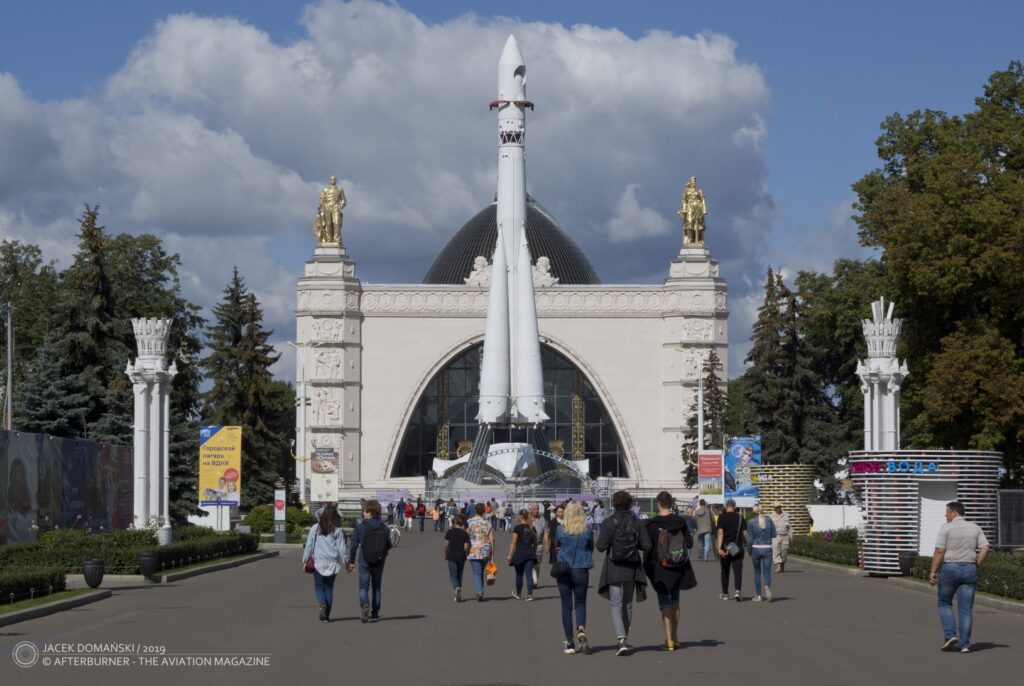
That initial space display survived to the time of collapse of the Soviet Union. Regrettably, starting from 1991, the exhibition was fading away and eventually the pavilion was designated for a mere marketplace.
The rebirth of space exhibition came in late 2010s. Firstly, the marketplace was closed and the pavilion was then used for a temporarily display related to Sochi 2014 Olympic Games and a few other shows. And in 2016 the reconstruction of the building started, being the joint project of the VDNH authorities and the United Rocket and Space Corporation (Объединённая ракетно-космическая корпорация).
Those difficult reconstruction works, that returned the pavilion its Socialist realism style, were finished in 2018. On 12th April, while celebrating the Cosmonautics Day, the now 34th pavilion and its new ´Space and Aviation´ exhibition (Космонавтика и авиация) were opened by the President of Russia Vladimir Putin and the Moscow Mayor Sergei Sobyanin, with the participation of cosmonauts V. Tereshkova, F. Yurchikhin and S. Krikalev.
Currently, there are more than 120 exhibits displayed in the pavilion, together with more than 2,000 documents, photos and video materials related to space and aviation. The exhibition is divided into three main sectors (although not firmly separated and sometimes interlocking) – the first part, starting behind the entrance gates, offers a wonderful walk through the history of space exploration and its milestones; another one is focused on understanding the outer space, laws of physics and getting to know about the Earth and the Solar system; and the third section tells about the future of space flights, showing the latest projects and ideas.
The first section, occupying the main area of the original building from the 1930s, begins with moving the visitor back to the early years of the space exploration. The full scale replicas of ´Sputnik 1´ (the first artificial Earth satellite) and ´Luna 1´ (the first spacecraft to reach the vicinity of the Moon) are among the highlights of this sector, together with Sputnik 2 (including Laika, the ´space dog´) and spacecraft from the Vostok programme – with the replica of the upper stage of ´Vostok 1´.
But, obviously, as the space research did not start in the 1960s, the visitors may also learn about the beginning of the Soviet space programme and the initial developments from the 1930s – this fascinating journey in time can be followed by the museum guests while investigating the displayed models, documents and photographs.

A wide collection of the 1:10 reduced-scale replicas presents the iconic spacecraft – starting with ´Sputnik 3´ (ISZ-3) satellite, then ´Voschod 2´ (a mission with the first spacewalk ever), series of Soyuz and Salut spacecraft, the Soyuz-Apollo programme, the ´Progress´ cargo ship and finally an amazing set of replicas showing the details of the abandoned Soviet lunar programme: N-1 rocket, UR-700 rocket, NK-33 and NK-43 rocket engines, and eventually a model of lunar landing module N1-L3.
The visitors may also find an amazing collection of rocket engines there. Many of them are the real, original items from the space programmes, as for example the RD-107A engine used with ´Voschod´ spacecraft or RD-170 from ´Energia´ rocket.
While walking through the ground level of the exhibition, the museum guests may get familiar with original equipment and instruments used in the early space missions, located among the big-size exhibits. Looking at those instruments, one could not resist the feeling how primitive they were, especially comparing to today´s technology, now surrounding us on daily basis.
Looking up, the visitors can see the full scale replica of ´Almaz´ space station, belonging to the top secret Soviet military space programme. This manned space station was planned to be launched in the late 1970s, however the development of automatic reconnaissance satellites caused there was no economic reason to continue with the crewed espionage spacecraft. Today, the replica of ´Almaz´ space station is among the top curiosities exhibited at VDNH.
But ´Almaz´ is not the only space station exhibited in the ´Space pavilion´. In the central point of the building, the full-scale replica of ´Mir´ station is located. The original station was in active service between 1986 and 2001, being the first modular space station ever made and the biggest artificial object orbiting the Earth. Both creating the ´Mir´ space station and the number of experiments performed by the station´s microgravity research laboratory are among the milestones of human space exploration. In 1998, ´Mir´ was succeeded by the International Space Station and then deorbited in March 2001.
This full-scale replica displayed at the VDNH includes ´Kristall´ laboratory (later known as ´Kvant 3´), a station base section, together with ´Kvant 1´ and ´Kvant 2´ modules. It is one of only two existing in the world full-scale models of the ´Mir´ space stations in the world – the second one is located in Europa-Park, Germany.
Although ´Mir´ is probably the biggest exhibit in the pavilion, and the initial expression is always emphasizing its size, the second thought returns us to reality and makes us aware how tight the space station was. Especially, that there is also a possibility to see ´Mir´ from the inside, because a part of the station is open for a short tour – the visitors may see the laboratory, connection module and base section.
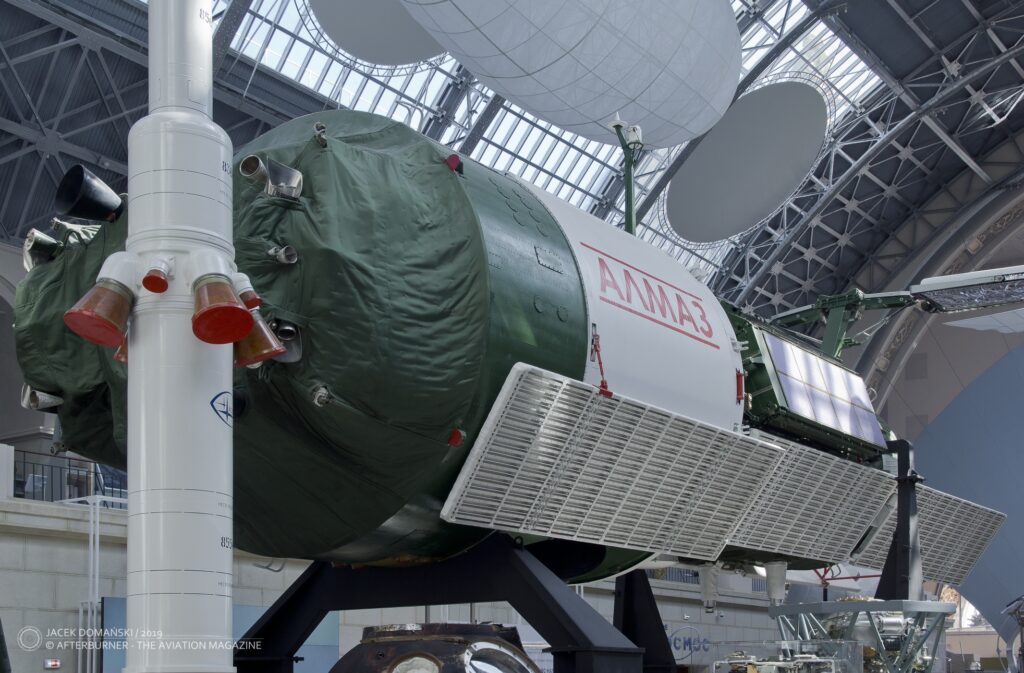
It is also worth mentioning here that there is also another one, much smaller, model of the Mir station located in the pavilion. That one shows the space station in ´full gear´, with all possible modules, cargo ships and solar panels.
An original re-entry capsule from ´Soyuz-TM´ and the brief introduction to ´Buran´ programme, including models and interactive panels, are closing the list of exhibits being the highlights of this journey in time. Obviously, there are still many other smaller items not mentioned here, that are displayed in the pavilion and ready to be explored by the visitors.
After walking through the area of original building, the museum guests enter the glass dome section, added to the pavilion in 1954. An interesting architectural design of the dome is a background for collection of satellites, exhibited above the visitors´ heads. Among the replicas displayed there, one can find the ´Ionosphere´, a series of ´Express´ satellites used, inter alia, within the Glonass positioning system, characteristic silhouette of ´Geo-IK-2´ or ´Prognoz´ spacecraft. There is also a scaled replica of the International Space Station, again showed in its full configuration.
Two upper galleries, located on the both sides of the main exhibition, shows the visitors the future ideas of space exploration and a variety of exhibits related to recent and currently ongoing space programmes.
The left-side gallery (as seen from the entrance) shows the projects focused on exploration of objects located within the Solar system. There are models of different spacecraft from the Luna programme there (including ´Lunokhod 2´) and also replicas of orbiters and landing modules from Venera project. A significant part of this display is also a forecast (hopefully not just a wishful thinking) of future space activities, based on the already developed space programmes – the visitors can see there the Moon and Mars landing and exploration crafts, space rovers and projects regarding the colonization of Mars and the Moon.
Among the right-side gallery highlights there is an interesting collection of original space suits in the pavilion, with such items as ´Berkut´, the first space suit allowing the spacewalk, or ´Orlan´, the suit developed for space station programme. There are also many models of currently operating rockets and spacecraft there, a diorama of the launching site at ´Baikonur´ spaceport and several related models, a few information about abandoned or not finished projects, and finally even more space instruments.
Last, but not least, several interactive points for younger visitors (but obviously not only for them!) must be mentioned. They are located all over the museum and allowing the guests to learn more about the outer space, the Earth and the Moon, space exploration in general and laws of physics. The space simulators located within the glass dome area are, with no doubts, the main attraction for children visiting the pavilion and there is always a big queue of ´space explorers´ there.

In addition, the interactive displays allows the visitors to speak with FEDOR autonomous humanoid robot (Final Experimental Demonstration Object Research) and even ask him some space-related questions, or to make the first contact with an alien intelligence, through creating patterns by gestures.
While you happen to be in this museum, you cannot forget about visiting the space shop located just at the entrance. It offers a broad range of space-related souvenirs and replicas, including models, books, t-shirts, patches, space food used by cosmonauts and many, many others. As most of such souvenirs are really unique, visiting this shop is really a must for any space exploration geek.
If, after visiting the ´Space pavilion´, one is still hungry of more space adventures, a short walk along the Prospect Mira alley is recommended. There, an ´Interactive museum complex “Buran”´ is located, consisting of the full-scale replica of ´Buran BTS-001´ and the museum building in the 20th pavilion. This small exhibition tells us the story of the Soviet space shuttle programme, there is a possibility to watch a few movies about the project, see this spacecraft from the inside and also become a part of the ´Buran´ crew during an interactive virtual tour.
For the younger visitors we can also recommend the ´Space playground´ situated nearby, with many items designed in the shape of spacecraft and other cosmic objects.
At the conclusion there are, as usual, a few useful information for those who are going to visit the VDNH area and the ´Space pavilion´. Finding the trade show park is easy, as it is located closely to the underground station of the same name – so there is no problem to get there from any place in Moscow. And the ´Space and Aviation´ exhibition can be seen easily, because of the ´Vostok´ rocket.
The pavilion is open from Tuesday to Sunday, 11:00 – 22:00 hours. A regular ticket costs 500 roubles (5.50 EUR), but there are also several possibilities of combined tickets, allowing to visit more than one exhibition at the VDNH for a discounted price. Sometimes the museum opens for free, but one must follow the VDNH web site for dates and details.

There is also an offer of group and individual guided tours, with the prices starting from 300 roubles (plus the entrance ticket). Those tours must be booked in advance via the VDNH web page. The space shop is accessible without ticket, there is also a free wi-fi in the pavilion – in case one would immediately like to share the impressions from the museum on social sites.
Although the ´Space and Aviation´ pavilion is located less than 20 minutes of walk from the famous and popular ´Museum of Cosmonautics´ situated within the ´Conquerors of Space´ memorial, the display at the VDNH is not so popular among the foreign tourists. And this is a pity, because the collection of exhibits there is just amazing and allows a huge amount of knowledge about the exploration of space. Without any doubts, visiting the ´Space pavilion´ and the VDNH area is strongly recommended for all aviation and space enthusiasts – especially that this year, at the 60th anniversary of Gagarin´s flight, an additional, special exhibition is planned to open there.
More images from the ´Space pavilion´ and the VDNH park:

